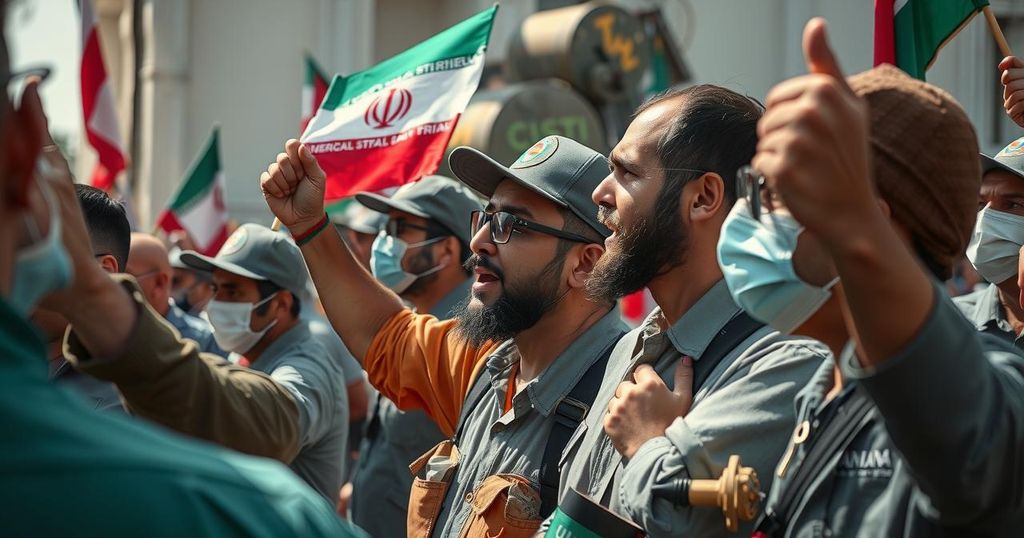Iran’s Labor Crisis: Workers Unite Against Government Policies

On January 13, various labor unions and retirees in Iran condemned the government’s anti-labor policies, warning of a crisis affecting workers. They criticized insufficient wage adjustments relative to the rising cost of living and highlighted the disconnect between official statistics and the actual financial needs of families. As protests grow and government suppression increases, there is a call for unity among oppressed classes to demand necessary reforms.
On January 13, several labor unions and retired workers in Iran collectively condemned the Iranian regime’s detrimental anti-labor policies, claiming it has marginalized workers and wage earners throughout the nation. The organizations, including the Haftapeh Sugar Cane Workers Union and the Coordinating Committee to Help Establish Labor Organizations, decried the government’s ineffective approach to labor rights, warning of a deepening crisis affecting the working class. The statement underscored that workers are key to national production, insisting that their contributions are essential to maintaining economic stability.
The signatories expressed grave concerns over wage policies they described as deteriorating when compared to previous years, predicting an accelerated crisis if the situation continues unchecked. They argued that the wages for workers, serving as the sole income for many families, should at least align with the urban cost of living. The labor groups asserted that wages should reflect the actual financial requirements of a family of four according to Iranian labor law, which mandates consideration of inflation and living costs in wage calculations. Current official statistics estimate the monthly cost of living between 32 and 37 million tomans, yet the groups insist that the reality is between 40 to 45 million tomans.
In contrast, the minimum wage stands at merely 11 million tomans, a figure many workers don’t even reach. Omid Nasibi, a member of the Parliament’s Councils and Internal Affairs Commission, recognized the severe challenges workers face, noting, “In the current inflationary conditions, the working class is unable to meet the cost of housing rent and livelihood. They are facing serious problems.” With projected increases in wages insufficient to combat the escalated cost of living, workers anticipate an ongoing decline in their purchasing power.
Iranians currently experience some of the lowest wages globally, notably trailing their regional neighbors, amid soaring inflation and an exponential rise in living costs. The labor organizations further criticized the regime for its inability to address these urgent issues, highlighting a growing disconnect between the government and its working populace. They called for solidarity amongst various societal groups, emphasizing that united action is essential to counteract the oppressive policies of the government.
As unrest continues to percolate within the nation, workers and other marginalized groups have been increasingly vocal about their demands. Demonstrations have become more frequent, with protesters voicing their dissatisfaction with the regime’s economic strategies. Despite the government’s measures to suppress these protests, labor activists remain undeterred, asserting the failure of such strategies to alleviate the workers’ plight.
The collective statement from labor organizations reflects a critical moment in Iran, urging for immediate and fundamental reforms. Without resolving the widening gap between wages and living costs, the Iranian regime finds itself at risk of losing the support of the very workforce necessary to sustain its economy. The ongoing protests illustrate both the pressing economic hardships and the urgent need for substantial policy shifts to better support the working class and foster stability.
The labor situation in Iran has reached a critical juncture, fueled by a combination of inadequate wages, high inflation, and governmental negligence towards the rights and needs of the working class. Labor organizations have united to voice their concerns, highlighting the disparity between the rising cost of living and stagnating wages. The Iranian regime’s failure to address these economic challenges has amplified discontent among workers, retirees, and activists, who are increasingly demanding change and accountability. The current economic landscape not only undermines the livelihoods of millions but also threatens the social fabric of Iranian society.
In summary, the collective outcry from labor unions and retirees in Iran reveals a pressing need for reforms in labor policies amidst a deteriorating economic landscape. The stark contrast between the unaffordable cost of living and inadequate wages highlights systemic failures within the Iranian regime’s approach to economic governance. As protest movements gain momentum, it is crucial for the government to engage with the working class proactively to avert further societal unrest. Failure to do so risks not only the stability of Iran’s economy but also the well-being of its citizens.
Original Source: irannewsupdate.com








